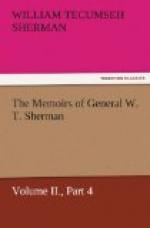General Howard will cross the Saluda and Broad Rivers as near their mouths as possible, occupy Columbia, destroy the public buildings, railroad property, manufacturing and machine shops; but will spare libraries, asylums, and private dwellings. He will then move to Winnsboro’, destroying en route utterly that section of the railroad. He will also cause all bridges, trestles, water-tanks, and depots on the railroad back to the Wateree to be burned, switches broken, and such other destruction as he can find time to accomplish consistent with proper celerity.
These instructions were embraced in General Order No. 26, which prescribed the routes of march for the several columns as far as Fayetteville, North Carolina, and is conclusive that I then regarded Columbia as simply one point on our general route of march, and not as an important conquest.
During the 16th of February the Fifteenth Corps reached the point opposite Columbia, and pushed on for the Saluda Factory three miles above, crossed that stream, and the head of column reached Broad River just in time to find its bridge in flames, Butler’s cavalry having just passed over into Columbia. The head of Slocum’s column also reached the point opposite Columbia the same morning, but the bulk of his army was back at Lexington. I reached this place early in the morning of the 16th, met General Slocum there; and explained to him the purport of General Order No. 26, which contemplated the passage of his army across Broad River at Alston, fifteen miles above Columbia. Riding down to the river-bank, I saw the wreck of the large bridge which had been burned by the enemy, with its many stone piers still standing, but the superstructure gone. Across the Congaree River lay the city of Columbia, in plain, easy view. I could see the unfinished State-House, a handsome granite structure, and the ruins of the railroad depot, which were still smouldering. Occasionally a few citizens or cavalry could be seen running across the streets, and quite a number of negroes were seemingly busy in carrying off bags of grain or meal, which were piled up near the burned depot.




